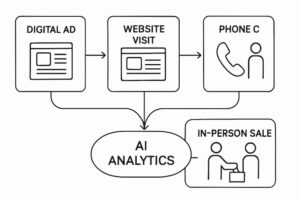Business
Turning Conversations Into Growth: How AI-Powered Conversation Analytics Connects Online Efforts With Offline Results
Table of Contents
- Bridging Digital and In-Person Sales: The New Role of AI
- The Value of Every Customer Conversation
- How Conversation Analytics Software Works
- AI Closing the Loop: Connecting Marketing to Revenue
- Overcoming Data Silos: From Clicks to Conversations
- Best Practices for Implementing AI-Powered Conversation Analytics
- The Future of Revenue Intelligence: What’s Next
Bridging Digital and In-Person Sales: The New Role of AI
Businesses have long struggled to align their ever-improving digital marketing strategies with the reality of offline, human interactions that close most deals. The disconnect between online engagement and in-person sales makes it challenging to assess the true impact of digital campaigns on revenue accurately. However, advances in conversation analytics software are helping companies bridge this costly gap by providing previously hidden insights into every customer engagement—whether online, over the phone, or face-to-face.
Conversation analytics powered by AI are revolutionizing how organizations track and measure the performance of their marketing efforts. These tools are transforming mountains of unstructured interactions into actionable intelligence, disrupting traditional models and enabling more effective sales and marketing integration than ever before.
The Value of Every Customer Conversation
Businesses often overlook the rich information contained in phone calls and live chats. Every customer conversation contains subtle signals, questions about pricing, objections, concerns, and moments of intent that, when analyzed at scale, reveal what truly drives purchasing decisions. According to Investopedia, effective customer service is not just about resolving issues, but understanding the customer’s journey and needs, which makes analyzing these interactions even more valuable. AI analytics can identify trends such as recurring questions, emotional triggers, or frequently mentioned competitors, enabling businesses to refine both their messaging and products.
How Conversation Analytics Software Works
AI-powered conversation analytics involves a suite of interconnected technologies. Call tracking assigns unique numbers to marketing campaigns, enabling businesses to identify which online ads or web pages prompted a customer to make a call. Calls are then recorded and transcribed using speech recognition technology. Machine learning algorithms categorize these conversations, identify the caller’s intent, and map the full customer journey. For more insights on maximizing the value of customer sentiment data, see this guide on conversation analytics.
Consider a scenario where a customer clicks a Google ad for urgent care, visits the website, and then calls to ask about insurance coverage. Conversation analytics tracks the original ad click, analyzes the call for intent (“insurance questions”), and records whether the caller books an appointment. This granular attribution ensures multiple teams have a clear view of how online marketing converts to real-world revenue.

AI Closing the Loop: Connecting Marketing to Revenue
One of the core advantages of AI conversation analytics is its ability to attribute offline sales directly to specific online campaigns, keywords, or even pieces of content. Marketers no longer have to guess which investments have the highest ROI—they can connect every call and conversation to its digital origin and impact on revenue. This empowers teams to double down on what works and cut wasted spend on underperforming tactics, ushering in a new era of closed-loop marketing. With AI, this level of insight is no longer reserved for the few who have massive analytics teams—businesses of all sizes can now harness the full revenue impact of their marketing strategies.
Overcoming Data Silos: From Clicks To Conversations
Achieving full-funnel attribution often comes up against the problem of data silos—systems that don’t communicate, making it tough to merge web analytics with customer interactions from calls or chats. Solutions include investing in APIs and integrations that unify web, CRM, and contact center data, ensuring marketing and sales teams can make informed decisions with a single source of truth. Some companies achieve this by setting up automated data pipelines, while others use all-in-one platforms designed for omnichannel analytics.
Best Practices for Implementing AI-Powered Conversation Analytics
- Align stakeholders early—from marketing and sales to IT and compliance—by clearly defining project goals and data needs.
- Begin with a pilot program in a single business unit or location to refine processes and demonstrate ROI.
- Integrate conversation data with your existing tech stack to make insights actionable across teams.
- Regularly audit your data for accuracy and relevance, and retrain AI models as business needs evolve.
- Prioritize consent and compliance, particularly in light of evolving data privacy regulations.
The Future of Revenue Intelligence: What’s Next?
As AI, voice recognition, and omnichannel analytics mature, the ability to turn every customer interaction into actionable growth intelligence will become even more sophisticated. Expect advances in real-time personalization, predictive intent mapping, and seamless integration across digital and physical touchpoints. Yet, the most successful brands will be those that use these tools not just to automate, but to enhance—combining machine-driven insight with human empathy and creativity.
In the rapidly evolving landscape of conversation analytics, the combination of AI and human innovation promises to redefine how companies connect the dots from marketing efforts to meaningful, measurable business outcomes.














